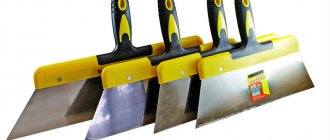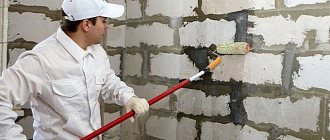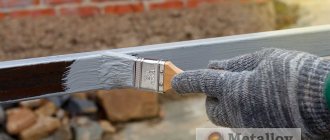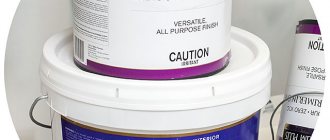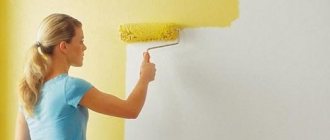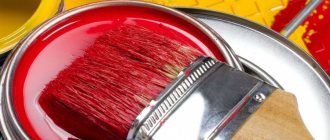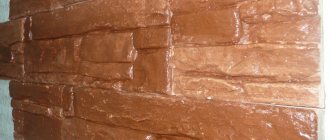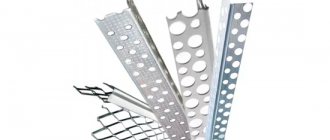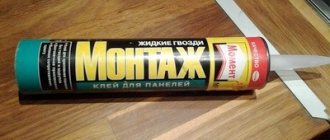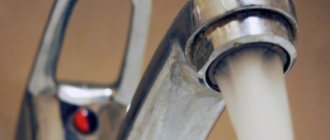Moisture has an amazing ability to destroy. In combination with temperature changes and other factors, moisture that has saturated a particular surface can ultimately lead to devastating consequences. Not to mention the fact that leaks are very likely in a number of rooms, which can cause great damage not only to your apartment, but also to the homes of your neighbors. A primer with waterproofing, which is also called hydrophobic, allows you to curb moisture.
Properties and characteristics of the material
A moisture-proof primer is a liquid material that not only forms a moisture-proof film on the surface, but also penetrates deeply into the pores of the entire base, making this protection dense internally as well. Plus, it significantly improves adhesion - the adhesion of paints and varnishes to painted surfaces. The scope of application of the primer is porous surfaces and substrates that actively absorb water and other liquids:
- concrete (here it is almost always used);
- brick base;
- plaster;
- putty;
- drywall and other less common materials.
The technical characteristics of water repellents are usually as follows:
- density – 1 kg/dm;
- storage and use temperature – up to 50 degrees C;
- material consumption – up to 2 liters per sq. m;
- drying time – up to 5-6 hours;
- achieving maximum water-repellent properties – 12 hours.
Purpose
It is used to remove dust, impart increased strength and water-repellent properties to floor coverings in workshops and warehouses, food industry enterprises, as well as in residential and office premises. Increases the limit of resistance to low temperatures. Prevents the appearance of cracks and increases the service life of floor surfaces. Significantly reduces the icing of concrete surfaces in winter and makes it easier to remove ice from the surface. Eliminates deposits of soluble salts on the surface, protects against the harmful effects of water and aggressive environments.
Types of water repellents and their characteristics
Penetrating impregnations
This is the name given to primers that penetrate deep into the base. They are usually used in the following cases:
- when laying floor floors in places with large crowds of people: shopping centers, cultural or sports premises, places of public events;
- when using dense types of concrete, where the pores are almost microscopic;
- to increase the density of the screeds.
Such impregnations are divided into 2 types: organic and inorganic.
Organic
They are based on acrylic, epoxy mixtures and polyurethane. They not only fill the pores, but actually bind the cement dust, which increases the durability of the coating. The main positive properties of organic impregnations are:
- increased level of strength;
- very low moisture permeability;
- experts note an almost complete absence of shrinkage;
- resistance to mechanical stress of any kind;
- no unpleasant odor upon application;
- There is also a decorative property: floors covered in this way acquire shine.
The only disadvantage of such impregnations is that they are usually not used outside buildings, because they turn yellow under prolonged exposure to direct sunlight.
Inorganic
They also have pronounced properties:
- such impregnations provide chemical reactions that increase the protective qualities of concrete from exposure to aggressive environments;
- prevent the formation of concrete dust.
Of the large range of penetrating impregnations, acrylic ones are the most popular; they are more affordable than others. But their lifespan is short-lived - after 2-3 years the coating procedure must be repeated.
Film-forming moisture-resistant soils
These primers, when dry, form a fairly reliable moisture-resistant film. They are divided into several specific types.
Concrete contact
This product is very good at promoting contact between paint and varnish materials and the surface being treated. In the manufacture of such a primer, acrylic dispersion and filler are used - quartz sand and cement.
ATTENTION! A prerequisite for use is that the surface must be smooth, without traces of fats and oils.
Bitumen primers
Unlike just bitumen, this composition no longer needs to be heated. It is ready to use immediately.
Before use, the mixture only needs to be thoroughly stirred, like oil paint. Very convenient and easy to apply.
The “liquid glass” solution is close to foam-forming mixtures. It is commonly used to cover the bottom and walls of swimming pools.
Moisture-resistant primer with deep penetration
They are usually produced on the basis of acrylic resins. Particles of such mixtures are capable of penetrating to a depth of the treated surface up to 2 cm.
Surface polyurethane primer
Many people consider this primer to be universal. It can be used on almost all substrates with varying degrees of porosity and absorbency. Equally convenient and suitable for concrete and wood.
IMPORTANT! Polyurethane primer can be applied to heated floors. Other mixtures do not fully provide adhesion to the surface under such conditions.
This primer is equally effective for exterior and interior work and is durable. The only drawback: this primer takes longer to dry than other types.
Surface polyurethane primer
Application of water-repellent primer for various surfaces and materials
Moisture-resistant primer for wood
It may be necessary before painting the floor and, especially, during furniture restoration. This type of primer has the following positive qualities:
- prevents the development of mold in the pores of a wooden surface;
- has antiseptic properties;
- prevents wood from cracking;
- reduces paint or varnish consumption;
- A well-chosen primer significantly improves the appearance of wooden coverings.
Moisture-resistant primer for drywall
It has the following advantages:
- the use of a primer strengthens the joints of drywall sheets;
- the mixture protects drywall from microorganisms that tend to form there;
- the primer strengthens the wall;
- drywall is sensitive to humidity, treatment is especially important in the kitchen, bathroom and toilet;
- the use of a primer prevents the wallpaper from peeling off, which is not uncommon when gluing it to drywall.
Not all soil mixtures are suitable for drywall. You can only use phenolic, alkyd and acrylic.
Waterproofing drywall in shower
Here such an event is simply necessary. Deep penetration mixtures are used. Joints and ends should be treated especially carefully. The most commonly used products in practice are “Dolphin” or “Hydrozit”.
Typically, plasterboard is used when making a shower stall yourself. If you do not use impregnation, this design will be very short-lived.
Moisture-resistant primer for drywall
The most popular types of primers on the market
- Iceberg VD-AK-013 . A universal composition that can be used both to impart hydrophobic properties to external walls and as a means for interior decoration. Can be used either independently or added to mortars. So, 0.5-2 liters of the composition per 50 kilograms of cement will give it hydrophobic properties. The material dries in 1 hour, and the consumption, depending on the surface being treated, is 300-600 grams per square meter;
- Glims Fobos Primer . A silicone resin with hydrophobic properties, used for treating facades or tile joints. The mixture is distinguished by low consumption - up to 250 grams per square meter, as well as excellent adhesive qualities for further finishing. For example, paint adheres to the composition much better;
- Ceresit CT-13 . The base is used for facade work, which makes the primer vapor-permeable and air-permeable. Hydrophobic properties appear after 4 hours, and gain full strength within a month, remaining for 10 years or more. Consumption depends on the surface being treated: concrete - 200 grams per square meter, and plaster - 700 grams. The material is based on silicone. The manufacturer recommends that before further actions, treat the surface with adhesive composition CT-17 in order to increase adhesion to paint or plaster. In this case, it is better to carry out work (plastering, puttying) no less than six months after applying the composition.
What should be the soil in the bathroom and toilet?
These rooms are areas of high humidity. Accordingly, the moisture resistance of the walls here needs to be treated with increased attention. The primer requirements here are very strict. She must be:
- antifungal - mold often accompanies such premises;
- not only moisture-resistant, but water-repellent;
- have the ability to increase the adhesion of the wall and paintwork or tile materials in conditions of contact with both cold and hot water.
The last point applies to the bathroom or combined bathroom.
It is logical to assume that the floor of such premises should also be waterproofed, but according to building codes approved back in 1988, bathrooms are considered low-intensity rooms; there is simply no exposure to liquids and similar mixtures. If you want to be on the safe side, apply a water-repellent primer yourself during the repair.
Waterproofing primer for concrete
Externally, concrete is a durable material, but it has high porosity. In this regard, its absorbency is relatively high, which contributes to the destruction of the material with frequent loss of moisture. In addition, when applying paint to a concrete surface, its consumption increases significantly.
Therefore, applying a primer here becomes a necessity. Typically, concrete is coated with deep penetration mixtures.
When choosing them, you should be guided by the following criteria:
- if the surface is made using concrete grades M 150 or M 300, select an epoxy or polyurethane primer;
- if finishing work is planned to be carried out at sub-zero temperatures, you can also use normal penetration soil;
- operating conditions and surface load should be taken into account;
- Often rooms with a concrete floor are industrial, here vibration load, impact and other similar factors should be taken into account.
Waterproofing primer for concrete
Hydrophobic primer for walls
The walls, of course, do not bear the same load as the floor, but primer is recommended here too for the following reasons:
- the surface is smooth and even;
- the strength of the wall increases;
- paint is applied much easier;
- Wallpaper is glued onto such a treated surface more smoothly, and it peels off less;
- In this way, certain design defects can be hidden.
Waterproof floor primer
The main task of such a mixture is to increase the adhesion of materials so that the floor covering lies flat on the base and is firmly attached. Mixtures in these cases are selected differentially.
For example, in a bathroom it is best to use deep-penetrating materials, in a children’s room - a mixture with an antiseptic effect, and it is more rational to cover the floors of an unheated dacha with an antifungal composition.
Water-repellent primer for wallpaper
There are no perfectly straight walls. You start to notice this when you start gluing wallpaper. To make the process more productive, it is recommended to apply a primer first. You can choose different types:
- acrylic mixtures are reliable, environmentally friendly, applied to all surfaces except iron, due to the risk of rust development;
- alkyd is well suited for wooden walls, but contact with plaster does not matter;
- glyphthalic - just right for metal walls;
- vinyl is best suited for liquid wallpaper.
Water-repellent primer for wallpaper
Advantages and disadvantages
This material, of course, has more advantages:
- the primer helps the adhesion of the materials used;
- prevents the formation of moisture;
- strengthens walls and floors;
- colored primer makes painting easier;
- such pre-treatment prevents the occurrence of mold and mildew;
- The process of applying the mixture is very simple.
The disadvantages of this building material include:
- Thick types of primer penetrate shallowly;
- liquids may contribute to the formation of stains;
- an incorrectly selected mixture can negatively affect the color of the walls or floor;
- the wrong type of mixture may not cope with rust or fungus;
- Some types have an unpleasant odor when applied.
However, it should be noted that none of these shortcomings are critical. They can be easily corrected if the choice of primer is carefully considered beforehand.
Primer consumption
The mixture consumption depends on the following factors:
- structure and composition of the surface: metal, concrete, wood, etc.;
- air temperature;
- composition and type of primer itself.
Approximately the consumption of different types looks like this:
- concrete contact – 350 g/sq. m.;
- alkyd – 120;
- dispersed – 100;
- wallpaper primer – 120;
- for metal – 120;
- for decorative plaster – 200.
As a rule, these parameters are indicated in the instructions. However, much depends on the specific circumstances; the data provided serves only as a recommendation. Of course, the qualifications of the craftsman carrying out the work also mean a lot.
Surface preparation
Before treating walls, floors or facades with waterproof material, it is necessary to carry out preparatory work clearly and step by step. The final result will depend on quality preparation.
Main stages of preparation:
- Clean the surface from any contaminants (debris, dust, grease stains, etc.).
- Clean off all protrusions and protruding fragments of old plaster.
- Using coarse sandpaper, sand the surface.
- Cracks and chips should be covered with plaster, and if necessary, leveling should be done using a starting cement composition.
- After complete drying, sand the surface again with sandpaper.
- Remove dust with a damp cloth.
The surface is prepared, you can start applying the primer.
